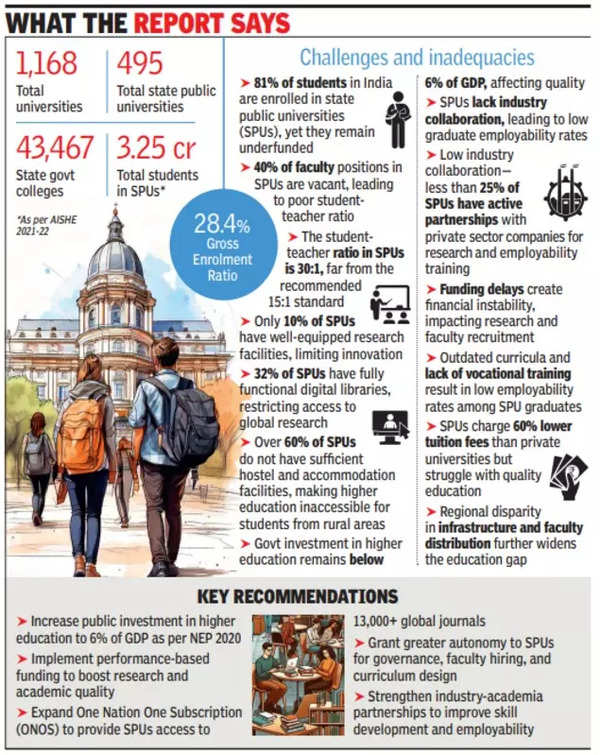Context
NITI Aayog has released a pioneering policy report titled “Expanding Quality Higher Education through States and State Public Universities (SPUs)”, marking the first comprehensive analysis of the role of State governments and SPUs in shaping India's higher education landscape. The report highlights funding disparities, gender enrolment trends, university density, and policy recommendations to enhance accessibility and quality in higher education.
Key Findings and Recommendations
Education Expenditure across States
-
- Jammu and Kashmir leads the country in education expenditure, allocating 8.11% of its GDP to education.
- Other states with high investments include Manipur (7.25%), Meghalaya (6.64%), and Tripura (6.19%).
- In contrast, larger states such as Delhi (1.67%), Telangana (2%), and Karnataka (2.01%) allocate significantly lower percentages.
- Jammu and Kashmir leads the country in education expenditure, allocating 8.11% of its GDP to education.
Despite an increase in per youth expenditure on higher education from ₹2,174 to ₹4,921 between 2005-06 and 2019-20, funding patterns among states remain highly uneven.
-
- Kerala, Tamil Nadu, Maharashtra, Andhra Pradesh, and Telangana consistently allocate higher per youth spending.
- Rajasthan, Punjab, and Chhattisgarh lag behind in investment.
- Kerala, Tamil Nadu, Maharashtra, Andhra Pradesh, and Telangana consistently allocate higher per youth spending.
Budgetary Allocations and Disparities
-
- Maharashtra leads in total higher education funding with ₹11,421 crore, followed by Bihar (₹9,666 crore) and Tamil Nadu (₹7,237 crore).
- States with smallest budgets include Sikkim (₹142 crore), Arunachal Pradesh (₹155 crore), and Nagaland (₹167 crore).
- Maharashtra leads in total higher education funding with ₹11,421 crore, followed by Bihar (₹9,666 crore) and Tamil Nadu (₹7,237 crore).
When considering higher education expenditure as a percentage of Gross State Domestic Product (GSDP):
-
- Bihar ranks highest at 1.56%, followed by Jammu and Kashmir (1.53%) and Manipur (1.45%).
- Telangana has the lowest allocation at 0.18%, while Gujarat and Rajasthan allocate only 0.23% of their GSDP to higher education.
- Bihar ranks highest at 1.56%, followed by Jammu and Kashmir (1.53%) and Manipur (1.45%).
Gender Disparities and University Density
The report provides insights into gender enrolment trends, highlighting states where female enrolment surpasses male enrolment, including Kerala, Chhattisgarh, and Himachal Pradesh. Smaller states and Union Territories like Chandigarh, Mizoram, and the Andaman and Nicobar Islands also maintain a balanced male-female enrolment ratio.
In terms of university density (number of universities per 1 million population):
-
- Sikkim leads with 10.3 universities per million people, followed by Arunachal Pradesh, Ladakh, Himachal Pradesh, Meghalaya, and Uttarakhand.
- Bihar records the lowest university density at 0.2 universities per million people, alongside other densely populated states like Uttar Pradesh, West Bengal, and Maharashtra.
- Sikkim leads with 10.3 universities per million people, followed by Arunachal Pradesh, Ladakh, Himachal Pradesh, Meghalaya, and Uttarakhand.
About NITI Aayog
NITI Aayog (National Institution for Transforming India) was established in 2015 as the government’s policy think tank to provide strategic advice.
Mandate of NITI Aayog
1. Oversee the Adoption and Monitoring of SDGs (Sustainable Development Goals): Tracks India's progress towards global SDG targets.
2. Promote Cooperative Federalism: Fosters collaboration between states and union territories for balanced development.
3. Provide a Framework for the National Agenda: Sets long-term development goals and policy directions.
4. Develop Mechanisms for Village-Level Planning: Strengthens grassroots-level development through effective planning and implementation.
The Way Forward
The report outlines nearly 80 policy recommendations to address disparities in higher education funding and accessibility. Key measures include:
-
- Increasing public funding for higher education, particularly in underfunded states.
- Enhancing infrastructure and academic standards at State Public Universities.
- Increasing public funding for higher education, particularly in underfunded states.








